Atelier Mediums
We have divided our mediums into two sections. The old mediums are familiar to Atelier Interactive users, and most of them are traditional in behaviour and convert the paint mixed with them into a traditional paint which does not respond to Unlocking Formula, but there are also some Interactive Mediums in this old section and the most popular of our existing mediums the Clear Painting Medium has been transferred to the new list because it does respond to Unlocking Formula.
Please note: Product packaging may vary slightly by location. Not all products available in all locations. Please check with your retailer.
NEW Atelier Mediums
Our new Atelier Mediums - introduced in late 2018 - are the result of years of work. We present them separately from the established Mediums because of their special features.
- They all have a double function: use with Unlocking Formula for prolonged blending, and use without Unlocking Formula for standard use.
- The mediums are arranged in a viscosity ladder making it easy for artists to match up the medium to the work that they are doing.
- They all dry to a satin finish which matches the heavy bodied paints Atelier Interactive and Atelier A2.
- It is important that these Mediums form a coordinated approach to the use of Mediums which artists should find very useful.
- All the established Mediums, such as Slow, Fast, Universal, etc., remain in place - see below.
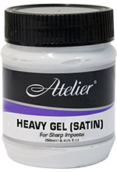
New! Heavy Gel (Satin)
This is a very heavy bodied thick gel which can be placed on the palette and mixed with the paint by picking up with a brush or palette knife and it works in just as easily as mixing a paint colour. The surface finish matches the satin finish of the paint.
Artists who would like to have a more oil paint like texture, using palette knife or brush for increased contrast and painterliness will like this medium because it is so easy to mix in.

New! Thick Painting Medium
Painting mediums for acrylics need to have a strong lubricating effect to help with blending. This medium has a very juicy paint-like viscosity, it will sit on the palette with the paint and should be used very generously to create a thick blanket like layer of wet paint without losing the painterly viscosity of the paint itself. Use at least one part to one part of paint, because the purpose of the Medium is to create a wet layer, ie. a blanket of wet paint, and once this is established you will not need to spritz with Unlocking Formula much or perhaps not at all, depending on the weather.
When you have finished a layer it can be dried easily by applying warmth (ie. sunlight, draft from an air conditioner or hair dryer).

New! Middle Medium
This new medium expands and advances on the formula of the popular Clear Painting Medium. It is used to lubricate the painting process but has a mid viscosity for spreading paint, and wet blending, but it also useful for edge blending wet over dry, and for scumbling and glazing.
The Thick Painting Medium and the Middle Medium are the key to easier acrylic painting and some artists may use both mediums while others may only need one according to their painting style. Middle Medium is best for smooth painting and Thick Painting Medium for ‘more painterly” styles.
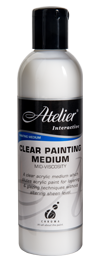
Clear Painting Medium - The Most Popular Existing Medium
This is the most popular existing Atelier painting medium and sits between the Middle Medium and the Thin Medium on the Viscosity Ladder. When mixed with Atelier Interactive, you create easy-to-manipulate mixtures that are also useful for edge blending wet over dry, for scumbling and for glazing. You can over paint layers once they are dry, but you can also use the Unlocking Formula to extend wet blending.

New! Thin Medium
This medium is a flow aide and its very liquid viscosity is useful for airbrush dilution or for liquefying heavy bodied paints for detailed work or thin glazes.
For more in depth videos, please go to our YouTube Channel.
The Established Atelier Mediums
The below mediums are staples in the Atelier Mediums range and consist of "interactive" mediums - mediums designed to work the Unlocking Formula and enhance the Atelier Interactive's wet blending ability - as well as "traditional" mediums - mediums designed for standard fast drying acrylic painting effects and/or do not respond well with Unlocking Formula.
You may not have thought about it before, but there is a rhythm to your painting process. How long is a painting session for you? Maybe you have a typical painting session lasting about 3 hours, or maybe about 2 hours, or maybe you like to keep painting on and off all day. Consider your painting routines to help you choose mediums that suit your painting habits.
The Established "Interactive" Mediums
These "interactive" mediums can be used with Unlocking Formula for prolonged blending, or without Unlocking Formula for standard uses. These "interactive" mediums do genuinely behave in new ways that have been developed to enhance the wet blending ability of Atelier Interactive paint, making it easier to use. They provide control for longer painting sessions, allowing the use of wet-in-wet techniques.
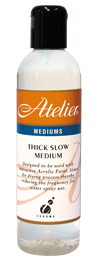
Thick Slow Medium
This is an old timer from the interactive medium range. If you use it, you need to plan your painting “alla prima” (all in one go) because you cannot over paint, maybe for several days. Thick Slow Medium is excellent for outdoor sketching, but is not as popular for indoor painting.

Clear Painting Medium - The Most Popular Existing Medium
This is the most popular existing Atelier painting medium. It is used to lubricate the painting process but has a mid viscosity for spreading paint, and wet blending, but it also useful for edge blending wet over dry, and for scumbling and glazing. You can over paint layers once they are dry, but you can also use the Unlocking Formula to extend wet blending.

Slow Medium (Low-Viscosity)
Extends wet-in-wet blending time and is designed to be used in conjunction with a water sprayer. It will tack up quite quickly but is very easily made workable again with the water sprayer. It is preferable to use a water sprayer to extend blending time, rather than adding more medium because if too much medium is added the paint will become tacky. This medium is useful for fine detail.
Additives Used To Control Drying

Unlocking Formula
An essential additive if you want to explore wet-in-wet painting. Allows artists to re-open Atelier Interactive even after it is touch-dry. Once the paint is re-opened, new paint can be blended back in, existing paint edges can be feathered or whole sections can be removed with a rag to reveal under layers. Spray apply using the Atelier Fine Mist Water Sprayer.
Use For Tone Control
All acrylic paints darken slightly when they dry. The tonal difference between wet and dry paint is minimal for darker colors but can be quite dramatic for lighter colors containing a large quantity of Titanium White in the mixture. If you want to adjust light tone values and your painting is touch dry, it will return to its wet values if you spray it with Unlocking Formula and this will allow you to make accurate wet-to-wet adjustments.

Retarder
A paint additive designed to slow down the drying time of acrylic paint. It may be added to other Atelier mediums to increase open time. Note: Retarder does not contain a binding agent so to avoid creating an unstable mixture, it is recommended to mix no more than 10% with acrylic paints.

Fine Mist Water Sprayer
A specifically designed sprayer which produces a controlled fine mist intended to keep Atelier Interactive workable for as long as desired. Fill with Unlocking Formula or water. Ideal for wet-in-wet techniques.
When to spray?
As the paint starts to dry you will feel your brush begin to drag. This means it is time to spray if you want to keep the paint wet and workable.
How to spray?
Hold the bottle back about 30cm from the painting and lightly mist the area you want to keep wet. The painting surface should not be physically disturbed by the water droplets so if you are getting large droplets or big dribbles then you are spraying too much.
What if the paint won’t re-wet?
After the paint has just dried it can still be reactivated with water but after about an hour, depending on the climate and paint thickness, you will need to use Unlocking Formula in your water sprayer to re-wet the paint.
Note: For larger works you may need to up‑size your sprayer in which case be sure to get one that delivers a fine mist of water and not a jet of heavy droplets.
Climate Note
Please download and refer to the short comments on climate. In Australia, there are often very dramatic differences in humidity level which can effect drying times and to give an example, if you live in a wet, humid, tropical area, you may decide that you have plenty of wet-in-wet blending time available when you are using traditional mediums and you also have a dry season. You can check your local humidity level on your smart phone, if you have one, and if you are working in an air conditioned space, your painting environment will be regulated, making it easier for you to choose which medium to use. What I do in this situation where obviously I can keep my paint wet easily but I can’t dry it off easily, is that I move on to a different painting and allow nature to take its course.
Traditional Mediums
Everyone uses traditional techniques which have been evolving since 1965. The Atelier Interactive paints will behave quite normally, and if you choose traditional mediums, they will also behave as you would expect them to. These Traditional Mediums contain a traditional acrylic binder that tends to dry quickly and form a tough water resistant skin.

New! Holding Medium
Holding Medium bodies Atelier Free Flow and Chroma's Jo Sonja Artists' Colours for a thicker more controlled painterly application.

Universal Medium/Varnish
The Universal Medium is a medium and varnish rolled into one.
As a medium, use as a fast medium for layering Small additions to the paint reduce viscosity sharply and layers dry faster.
As a water-based varnish, it is comparable to solvent varnish. It is very easy to apply. It gives the color saturation and enhancement of a good solvent based varnish. By adding water to the concentrate, different levels of sheen can be created between low sheen and high gloss. Artists should experiment with color swatches to decide on the finishes that they prefer, as it is non-removable. (For a removable varnish, see Chroma Solvent Finishing Varnishes.
Directions: Apply a seal coat of one part varnish:one part water. This allows the varnish to penetrate and seal the paint layer so that a more concentrated varnish can be spread easily when the seal coat is dry. Use full strength for a gloss finish or thin with water for a satin finish.

Glazing Liquid (Gloss)/Acrylic Glazing Liquid
A low-viscosity medium for creating translucent glazes. Slightly extends open time and is waterproof when dry. Mix with paint for added translucency with a rich oil-like gloss sheen. Promotes flow and leveling.

Fast Medium/Fixer
Designed to speed the Interactive Acrylic painting process by quickly fixing a paint layer. Use to dilute paint for glazing and thin painting techniques, or when you want to speed up layering.
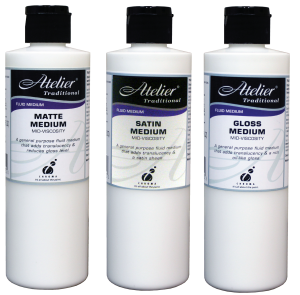
Matte, Satin & Gloss Medium
General purpose mid-viscosity mediums that add translucency and adjust for a matte, satin or gloss sheen. Ideal for glazing and extending colors. They promote flow and leveling.
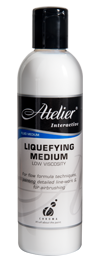
Liquefying Medium
Atelier Liquefying Medium is a water-based medium which increases the fluidity of acrylic paint. It is ideal for detailed fine line work and airbrushing techniques.

New! Pouring Medium
Designed for extreme fluid effects and pouring techniques. Self leveling and dries to a gloss finish. The best paint to use with this medium is Atelier Free Flow.
Gels & Pastes
These traditional compounds add texture and structure as well as extend the paint. They can be mixed with the paint or applied on top.
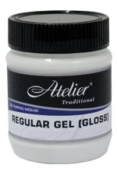
Regular Gel (Matte & Gloss)
An acrylic gel with a smooth buttery consistency. Use as a paint extender to adjust gloss and transparency without altering consistency. Mix with paint to increase body or apply directly on top of a paint layer for a transparent textural effect. Holds moderate peaks and texture for impasto effects. Milky color becomes transparent when dry.
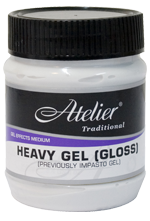
Heavy Gel Gloss (Impasto Gel)/Heavy Gel Matte
A thick, water-based, acrylic gel designed to exaggerate structure and sharpen textural edges of the paint in acrylic painting. Heavy Gel Gloss also increases the gloss level of the paint and can also be used as an adhesive to bond other materials to the painting. Heavy Gel Matte behaves like Heavy Gel Gloss, but dries to a satin-matte finish.
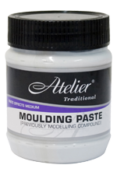
Molding Paste (Formerly Modeling Compound)
A very thick, textural paste used for exaggerated structure. Molding Paste has the same flexibility as Atelier paints and is used to create strong textural interest at any stage in a painting’s process. Dries white. Can be mixed with paint to produce a colored ground or painted over once dry.
Other Products

Waterproof Drawing Ink
May be used directly from the container or diluted with water. Produces an intense black through to mid-tone grey and pale grey washes. Ideal for brush or pen work.

Chroma Incredible Brush Cleaner
Ideal for revitalizing old hard paintbrushes. This product is made from a special formulation which is designed to break through hardened acrylic, oil or lacquer on natural and synthetic paintbrushes, bringing them back to life.
